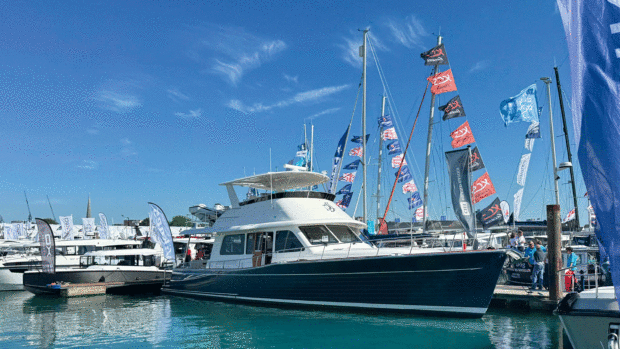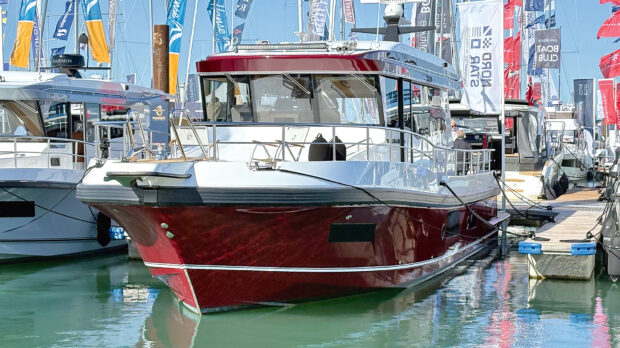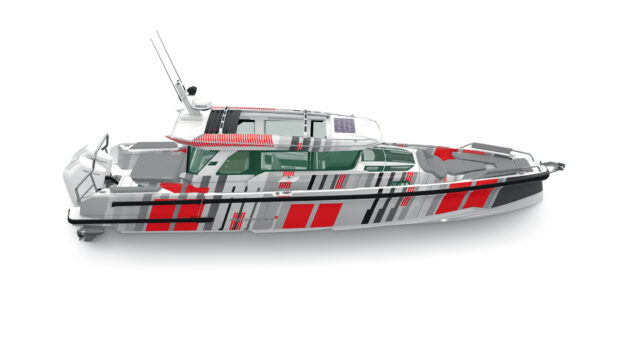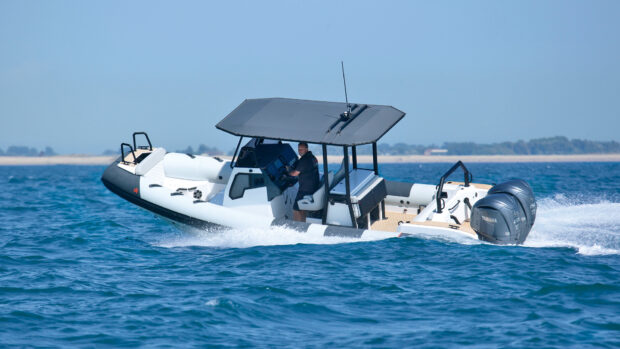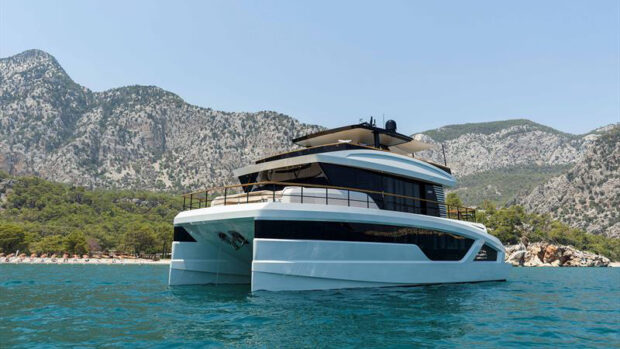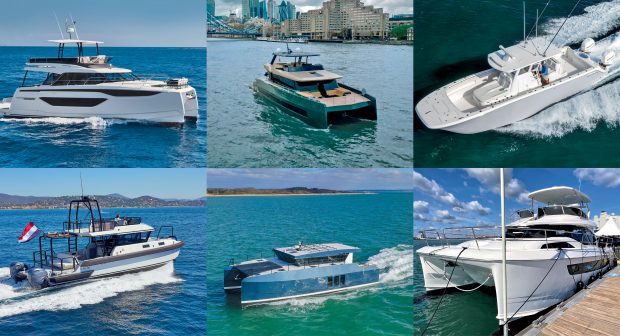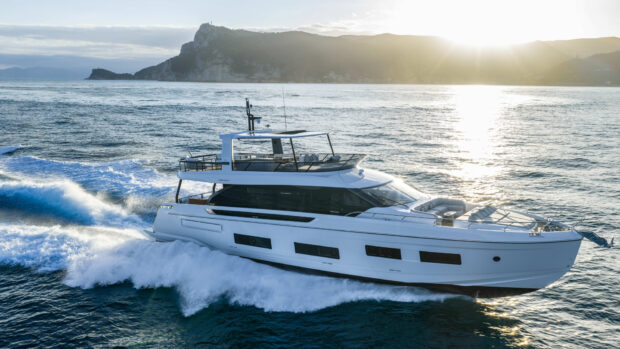After three years of construction, Will Brocklebank takes delivery of only the second Rustler 41 ever built...
Tuesday had been pencilled in for the launch, but a biblical deluge turned Penryn into a blue-grey waterfall and revealed a small leak in the sealant around one of the saloon windows. My solace was the thought that if there’s got to be a leak it’s a hell of a lot better above the waterline!
The Rustler team duly stood in the downpour recaulking, with plastic sheeting tenting the area, and by Wednesday morning, the sky was scrubbed clean and the leak was banished.
The big launch
As I watched them gently lower Ennor into the water, the mechanical lead threaded himself through the engine room, zapping everything with his IR thermometer. The electrical engineer was equally busy, zig-zagging through the forest of CZone modules and Mastervolt components she had installed.
We slipped out into the Fal with barely a ripple and when I brought the throttles up, she ran sweetly on her twin 370s, planing by 15 knots and settling into a 22.5‑knot cruise until the port engine died. Apparently, a loose bag strap had caught a fuel shut-off! Tap open, line bled, dignity mostly intact, and we were back on song inside five minutes.
Being at the helm for the first time felt all the sweeter because the path here had been eventful. It was a three-year process and I realised I’d never looked forward to something for this long in my life. I met and married my wife in half the time.
The build wasn’t without its dramas – six-month delays on hull moulds, wrong-ratio gearboxes swapped out from under the engines, and rope cutters from New Zealand that arrived without fittings or a workable design, only to be heroically re-machined locally.
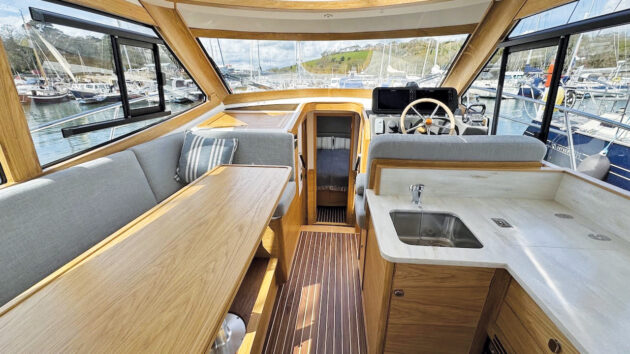
Clever storage solutions help keep the galley sleek
The striking single‑piece curved windscreen limped into the yard in mid‑February, weeks behind schedule, and demanded crane muscle and needlepoint precision. Then, three days before launch week, both engines began throwing error codes.
After 60 hours of systematic testing, the fault was traced to the ECUs. Fresh units were found, flashed and fitted, and the happy burble of the diesels filled the yard. I have project‑managed historic building renovations and run high‑tech engineering teams, but I don’t think I’ve ever seen quite so many concurrent hurdles across such a spectrum of disciplines – composites, hydraulics, NMEA networks, suppliers – being coolly managed to such a first‑class outcome.
My Friday FaceTime sessions had become quite the ritual. I would sit at my desk with a mug of tea while the Rustler team walked me from stem to stern. Any boat owner will know the pain of a snagging-list that seems to grow faster than you can address it, and it was humbling to watch a handbuilt object of this complexity come together and still look so neat: wiring looms laced into perfect right angles, locker lids shutting with the hush of a Bentley door, joinery that would make an 18th-century French cabinet-maker blush with pride.
Specced to perform
I intend to run Ennor to all the rock lighthouses around Britain, often alone and often at night, so I’ll encounter some dark and stormy seas. Visibility was therefore non-negotiable. A low-slung Rustler 41 barely pings a commercial radar, so an Active X target enhancer gives Ennor the radar signature of a small cruise liner.
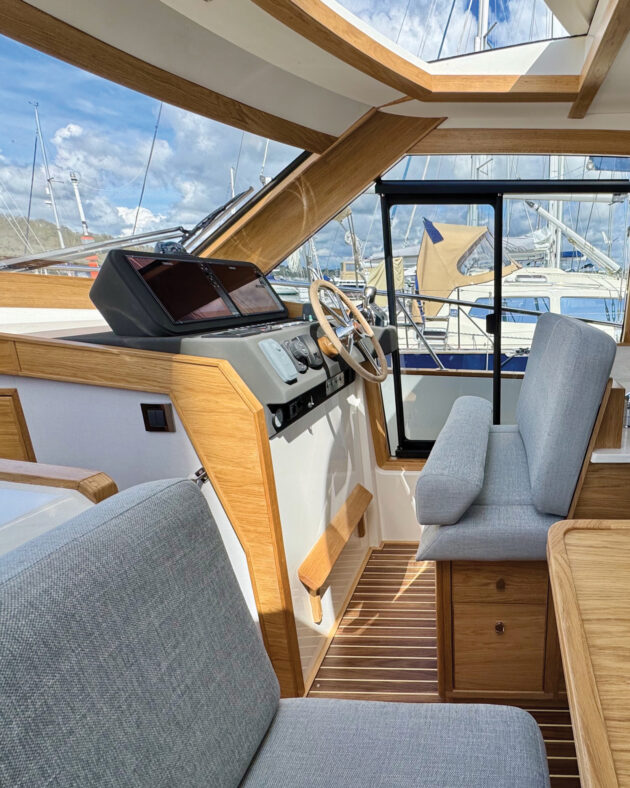
Active X target enhancer makes Ennor highly visible
Up top, a 20in Lumishore LED light bar reveals the lobster pots, and a Marinco joystick‑controlled spotlight lets me pick out mooring buoys without leaving the helm. For the really dark nights, an Omnisense Ulysses Micro S+ thermal camera, gyro‑stabilised and scarcely bigger than a pasty, paints infrared shapes of fishing boats and rocky headlands on the Simrad screens.
Discreet bullet cameras at the bow and stern also provide wide‑angle feeds for docking, for checking the anchor chain and for reversing into berths without guesswork.
Lighthouses aside, anchoring among Scotland’s outer islands also brings its own complications. Think large tidal ranges, fitful winds and plenty of room for the boat to wander at the end of 60m of chain.
Traditional GPS anchor alarms, which work off the boat’s position, deliver a 100m radius of uncertainty. VisionAnchor solves that problem with a bright reflective buoy that floats directly above the anchor itself, carrying its own multi‑constellation GPS. If the hook drags a metre, a remote alarm and a phone app let me know long before crunch time. Clever stuff.
Storage was the next obsession. Conventional fenders and a tender would swallow half the cockpit lockers and clutter the swim platform, but inflatable alternatives offered a radical solution. Fendertex fenders, custom‑coloured and abrasion‑resistant, deflate to the size of a rolled‑up pair of trousers. They inflate in under a minute, hang neatly from the stainless fender hooks and occupy less than half the room of one ordinary fender.
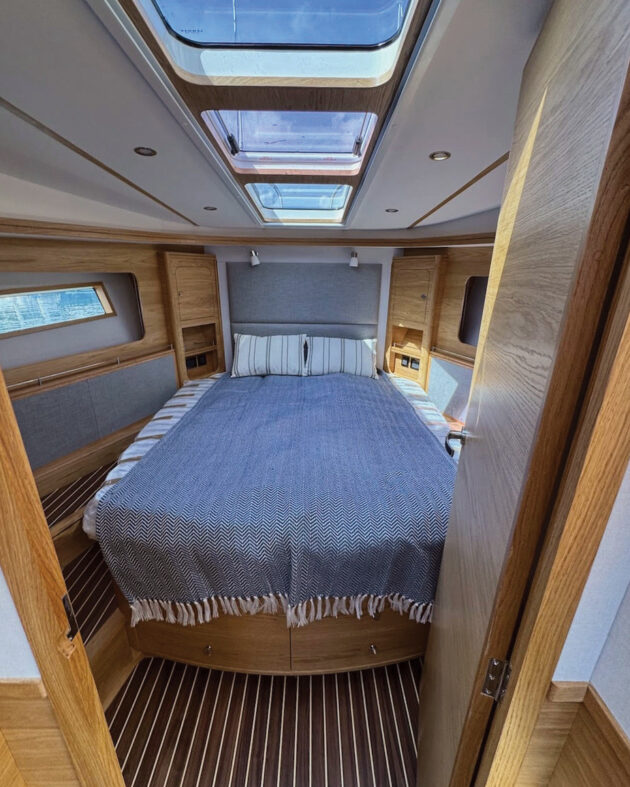
Throws by Weaver Green add a cosy touch
For ship‑to‑shore work, the EZ Raft tender is just as clever. It combines a 3.2m inflatable trimaran with a 5hp Torqeedo electric outboard and yet it stows in a bag that slides into my transom locker. To make light work of the pneumatics, I also have a Scanstrut Atmos inflator built into the wet‑bar. You simply dial in the pressure, clip on the hose and sit back as they pop into shape.
Pleasant and practical
Life on board should be comfortable as well as practical. Weaver Green rugs and cushions, woven from recycled plastic bottles yet astonishingly soft, bring colour to the berths and double as cosy foredeck wraps to use on chilly summer evenings. Rain and dew beads can make them damp, so they go straight in the washing machine when needed.
In the galley, rather than take up precious space with timber plate and glass racks, I turned to Silwy’s amazing magnetic glassware and crockery. Each plate, glass and mug carries an internal magnet that grips soft metal‑infused coasters and mats, so they stay on your tables in rough seas. There are no annoying rattles coming from storage compartments, and mugs can even hang upside‑down from a locker ceiling, creating space where none existed.
So, now, with the gremlins banished and the final snags down to minor items, Ennor feels ready for her grand adventures.
Our shakedown sail will be out to the Fastnet Rock. If the weather behaves, the gear performs as well in anger as it does on paper and the fridges keep everything cold, I’ll count the 13‑month delay as nothing more than extra seasoning in a story that I’m hoping will be rich in adventure.
 If you enjoyed this….
If you enjoyed this….
Motor Boat & Yachting is the world’s leading magazine for Motoryacht enthusiasts. Every month we have inspirational adventures and practical features to help you realise your sailing dreams, as well as tests and news of all the latest motorboats.
Plus you’ll get our quarterly Custom Yachting supplement where we share the last on offer in the superyacht world and at the luxury end of the market.
Build your knowledge with a subscription delivered to your door. See our latest offers and save at least 30% off the cover price.
Note: We may earn a commission when you buy through links on our site, at no extra cost to you. This doesn’t affect our editorial independence.


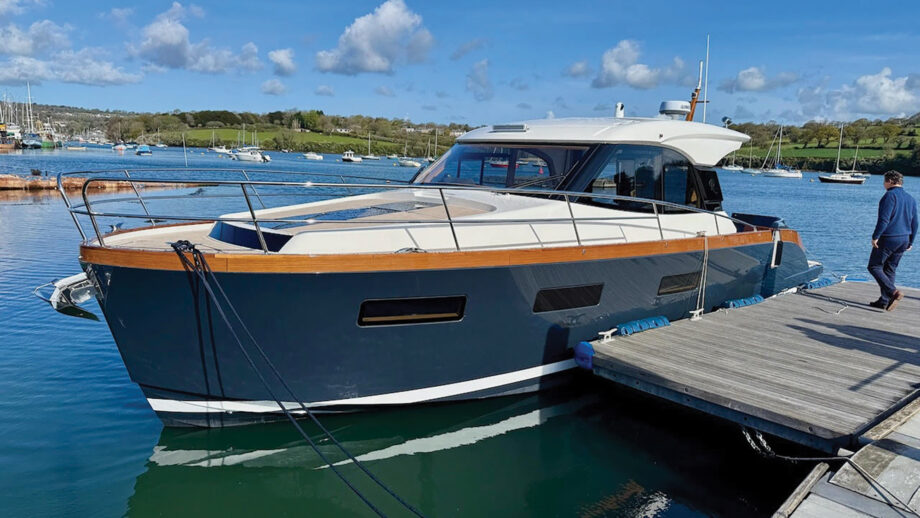
 If you enjoyed this….
If you enjoyed this….